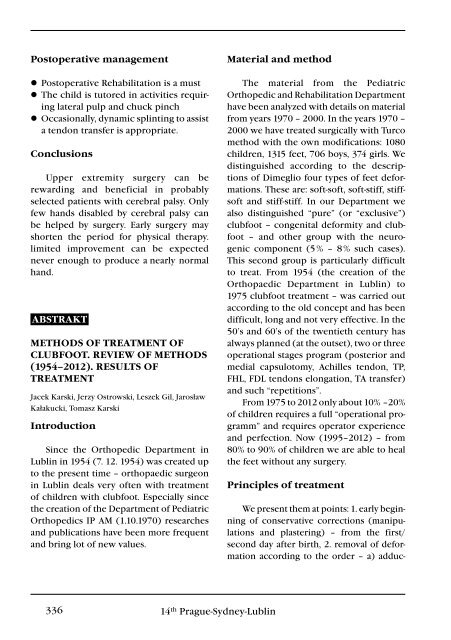3+4+Supplementum/2012 - Společnost pro pojivové tkáně
3+4+Supplementum/2012 - Společnost pro pojivové tkáně
3+4+Supplementum/2012 - Společnost pro pojivové tkáně
- TAGS
- www.pojivo.cz
Create successful ePaper yourself
Turn your PDF publications into a flip-book with our unique Google optimized e-Paper software.
Postoperative management<br />
z Postoperative Rehabilitation is a must<br />
z The child is tutored in activities requiring<br />
lateral pulp and chuck pinch<br />
z Occasionally, dynamic splinting to assist<br />
a tendon transfer is ap<strong>pro</strong>priate.<br />
Conclusions<br />
Upper extremity surgery can be<br />
rewarding and beneficial in <strong>pro</strong>bably<br />
selected patients with cerebral palsy. Only<br />
few hands disabled by cerebral palsy can<br />
be helped by surgery. Early surgery may<br />
shorten the period for physical therapy.<br />
limited im<strong>pro</strong>vement can be expected<br />
never enough to <strong>pro</strong>duce a nearly normal<br />
hand.<br />
aBSTRakT<br />
MeTHOdS Of TReaTMenT Of<br />
CluBfOOT. ReView Of MeTHOdS<br />
(1954–<strong>2012</strong>). ReSulTS Of<br />
TReaTMenT<br />
Jacek Karski, Jerzy Ostrowski, Leszek Gil, Jarosław<br />
Kałakucki, Tomasz Karski<br />
introduction<br />
Since the Orthopedic Department in<br />
Lublin in 1954 (7. 12. 1954) was created up<br />
to the present time – orthopaedic surgeon<br />
in Lublin deals very often with treatment<br />
of children with clubfoot. Especially since<br />
the creation of the Department of Pediatric<br />
Orthopedics IP AM (1.10.1970) researches<br />
and publications have been more frequent<br />
and bring lot of new values.<br />
336 14 th Prague-Sydney-Lublin<br />
Material and method<br />
The material from the Pediatric<br />
Orthopedic and Rehabilitation Department<br />
have been analyzed with details on material<br />
from years 1970 – 2000. In the years 1970 –<br />
2000 we have treated surgically with Turco<br />
method with the own modifications: 1080<br />
children, 1315 feet, 706 boys, 374 girls. We<br />
distinguished according to the descriptions<br />
of Dimeglio four types of feet deformations.<br />
These are: soft-soft, soft-stiff, stiffsoft<br />
and stiff-stiff. In our Department we<br />
also distinguished “pure” (or “exclusive”)<br />
clubfoot – congenital deformity and clubfoot<br />
– and other group with the neurogenic<br />
component (5 % – 8 % such cases).<br />
This second group is particularly difficult<br />
to treat. From 1954 (the creation of the<br />
Orthopaedic Department in Lublin) to<br />
1975 clubfoot treatment – was carried out<br />
according to the old concept and has been<br />
difficult, long and not very effective. In the<br />
50’s and 60’s of the twentieth century has<br />
always planned (at the outset), two or three<br />
operational stages <strong>pro</strong>gram (posterior and<br />
medial capsulotomy, Achilles tendon, TP,<br />
FHL, FDL tendons elongation, TA transfer)<br />
and such “repetitions”.<br />
From 1975 to <strong>2012</strong> only about 10% –20%<br />
of children requires a full “operational <strong>pro</strong>gramm”<br />
and requires operator experience<br />
and perfection. Now (1995–<strong>2012</strong>) – from<br />
80% to 90% of children we are able to heal<br />
the feet without any surgery.<br />
Principles of treatment<br />
We present them at points: 1. early beginning<br />
of conservative corrections (manipulations<br />
and plastering) – from the first/<br />
second day after birth, 2. removal of deformation<br />
according to the order – a) adduc-

















